2021 Q3 High Yield Quarterly
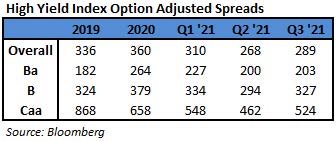
In the third quarter of 2021, the Bloomberg Barclays US Corporate High Yield Index (“Index”) return was 0.89% bringing the year to date (“YTD”) return to 4.53%. The CAM High Yield Composite net of fees total return was 1.10% bringing the YTD net of fees return to 3.56%. The S&P 500 stock index return was 0.58% (including dividends reinvested) for Q3, and the YTD return stands at 15.91%.
The 10 year US Treasury rate (“10 year”) had a move down to a 1.17% low in early August and then moved back up to finish at 1.49%, up 0.02% from the beginning of the quarter. Over the period, the Index option adjusted spread (“OAS”) widened 21 basis points moving from 268 basis points to 289 basis points. Each quality segment of the High Yield Market participated in the spread widening as BB rated securities widened 3 basis points, B rated securities widened 33 basis points, and CCC rated securities widened 62 basis points. Take a look at the chart below from Bloomberg to see a visual of the spread moves in the Index over the past five years. The graph illustrates the speed of the spread move in both directions during 2020 and the continuation of lower spreads in 2021. The OAS record low (not shown) is 233 basis points set back in 2007.
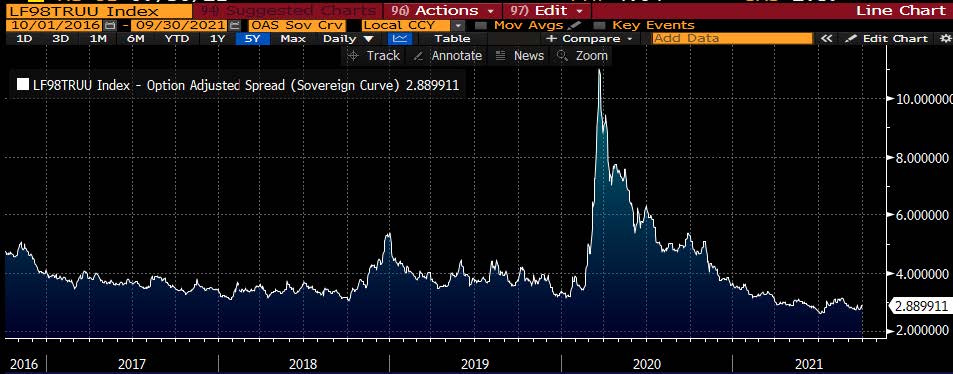
The Energy, REITs, and Other Financial sectors were the best performers during the quarter, posting returns of 1.70%, 1.22%, and 1.17%, respectively. On the other hand, Finance Companies, Consumer Cyclicals, and Communications were the worst performing sectors, posting returns of 0.44%, 0.56%, and 0.56%, respectively. Clearly the market was strong as no sector posted a negative return in the period. At the industry level, life insurance, independent energy, restaurants, and paper all posted the best returns. The life insurance industry posted the highest return 3.43%. The lowest performing industries during the quarter were refining, gaming, cable, and health insurance. The refining industry posted the lowest return -0.63%.
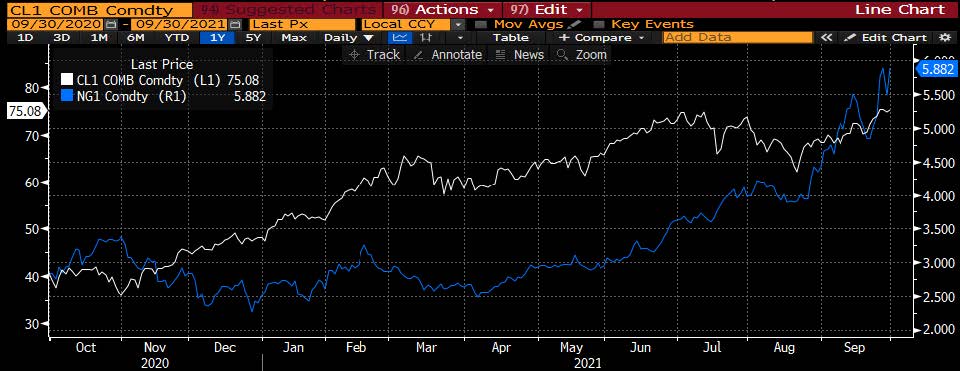
The energy sector performance has continued to remain strong. While crude oil held its own averaging $70 per barrel in Q3, the natural gas market has moved steadily higher. The acceleration to the upside is a function of both supply and demand being impacted. Excessive summer heat particularly in the northwest called for higher than normal power demand. This left a situation of below average gas storage. Then hurricane Ida resulted in knocking much of the Gulf of Mexico production offline. In fact, over 75% of the production is still shut-in. The icing on this story is that traders are beginning to look towards the possibility of a colder than normal winter. If that situation comes to be more priced in as consensus, this price train will just keep chugging higher.
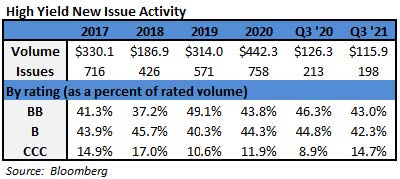
During the third quarter, the high yield primary market continued its record pace and posted $115.9 billion in issuance. Many companies continued to take advantage of the open new issue market that is offering very attractive financing. Year to date there has been $433 billion in issuance and will no doubt set a new record by topping last year’s $442 billion. The issuance in Consumer Discretionary continued to be very strong with approximately 22% of the total during the quarter. Financials issuance was best for second place by making up 17% of the total new paper placed in the market.
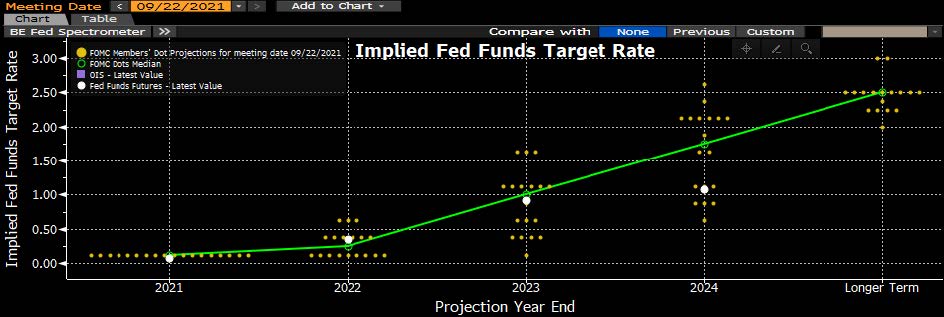
The Federal Reserve maintained the Target Rate to an upper bound of 0.25% at both the July and September meetings. The chart to the left shows the updated Fed dot plot post the September meeting. Also, the market is currently pricing in one rate hike by year end 2022.i As expected, the Fed signaled that the time to taper is at hand with Chair Powell commenting that tapering “could come as soon as the next meeting.” He further noted that the taper is separate and distinct from rate hikes by saying “the timing and pace of the coming reduction in asset purchases will not be intended to carry a direct signal regarding the timing of interest-rate liftoff.”ii The transitory nature of red hot inflation is very much a front and center concern with supply chain issues being particularly troubling. Recently, on a panel including several central bankers from across the globe, Powell said “it is also frustrating to see the bottlenecks and supply chain problems not getting better — in fact, at the margin, apparently getting a little bit worse. We see that continuing into next year, probably, and holding inflation up longer than we had thought.”iii On October 1st, the personal consumption expenditures report was released. This is a price gauge that the Fed uses for its inflation target. The report showed the largest increase in 30 years.
Intermediate Treasuries increased 2 basis points over the quarter, as the 10-year Treasury yield was at 1.47% on June 30th, and 1.49% at the end of the third quarter. The 5-year Treasury increased 8 basis points over the quarter, moving from 0.89% on June 30th, to 0.97% at the end of the third quarter. Intermediate term yields more often reflect GDP and expectations for future economic growth and inflation rather than actions taken by the FOMC to adjust the Target Rate. The revised second quarter GDP print was 6.7% (quarter over quarter annualized rate). Looking forward, the current consensus view of economists suggests a GDP for 2022 around 4.1% with inflation expectations around 2.5%.iv
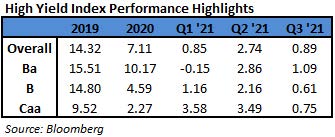
Being a more conservative asset manager, Cincinnati Asset Management Inc. does not buy CCC and lower rated securities. This policy generally served our clients well in 2020. However, the lowest rated segment of the market has outperformed year to date in 2021. Thus, our higher quality orientation was not optimal during the first half of the year, but it was once again a benefit during Q3. As a result and noted above, our High Yield Composite gross total return has underperformed the Index YTD. However, our Composite did outperform over the third quarter measurement period. With the market staying strong during the third quarter, our cash position remained a drag on overall performance. Outside of that, credit selection drove much of the story in Q3. The downside was driven by selections in the consumer cyclical services and wirelines industries while the top positive offsets were found within aerospace/defense, autos, and transportation
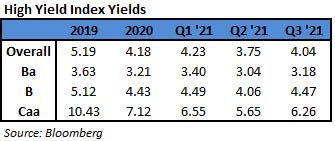
The Bloomberg Barclays US Corporate High Yield Index ended the third quarter with a yield of 4.04%. The market yield is an average that is barbelled by the CCC-rated cohort yielding 6.26% and a BB rated slice yielding 3.18%. Equity volatility, as measured by the Chicago Board Options Exchange Volatility Index (“VIX”), had an average of 18 over the quarter. For context, the average was 15 over the course of 2019 and 29 for 2020. The third quarter had zero bond issuers default on their debt. The trailing twelve month default rate fell to 0.92% with the energy sector accounting for about a third of that rate.<sup>v</sup> The current 0.92% default rate is relative to the 5.80%, 6.17%, 4.80%, 1.63% default rates for the third and fourth quarters of 2020, and the first and second quarters of 2021 respectively. Pre-Covid, fundamentals of high yield companies had been mostly good and in the aggregate fundamentals are back to those pre-covid levels. From a technical view, fund flows were roughly flat in July, positive in August and September, and the year-to-date outflow stands at $1.3 billion.<sup>vi</sup> In spite of this outflow, a strong bid remains in the market for high yield paper, and the declining default rate is keeping a risk on attitude in place for market participants. We are of the belief that for clients that have an investment horizon over a complete market cycle, high yield deserves to be considered as part of the portfolio allocation.
It is quite interesting to think through just how much has transpired over the last year and a half. The US has spent trillions in response to the covid pandemic providing support to people and companies impacted. The vaccine has been rolled out and according to the CDC, 77% of the US population ages 18+ has received at least one shot. This is up from 55% at the time of our Q2 commentary and 32% as of our Q1 commentary. As a country, we are currently in a place where the economy is booming and inflation is escalated. The Federal Reserve has signaled that they will begin the taper of asset purchases in short order. Moving from Q3 into Q4, Congress is wrangling with funding to avoid a shutdown, raising the debt ceiling, passing an infrastructure bill, and passing a fresh social programs spending bill that will have a price tag in the trillions of dollars. There is certainly no slowdown of information flow as we move into the last quarter of 2021. Clearly, it is important that we exercise discipline and selectivity in our credit choices moving forward. We are very much on the lookout for any pitfalls as well as opportunities for our clients. We will continue to carefully monitor the market to evaluate that the given compensation for the perceived level of risk remains appropriate on a security by security basis. As always, we will continue our search for value and adjust positions as we uncover compelling situations. Finally, we are very grateful for the trust placed in our team to manage your capital through such a historic time.
This information is intended solely to report on investment strategies identified by Cincinnati Asset Management. Opinions and estimates offered constitute our judgment and are subject to change without notice, as are statements of financial market trends, which are based on current market conditions. This material is not intended as an offer or solicitation to buy, hold or sell any financial instrument. Fixed income securities may be sensitive to prevailing interest rates. When rates rise the value generally declines. Past performance is not a guarantee of future results. Gross of advisory fee performance does not reflect the deduction of investment advisory fees. Our advisory fees are disclosed in Form ADV Part 2A. Accounts managed through brokerage firm programs usually will include additional fees. Returns are calculated monthly in U.S. dollars and include reinvestment of dividends and interest. The index is unmanaged and does not take into account fees, expenses, and transaction costs. It is shown for comparative purposes and is based on information generally available to the public from sources believed to be reliable. No representation is made to its accuracy or completeness.
i Bloomberg September 30, 2021: WIRP – World Interest Rate Probability
ii Bloomberg September 22, 2021: Powell Says Fed Taper Could Start ‘Soon’
iii The New York Times September 29, 2021: The World’s Top Central Bankers See Supply Chain Problems Prolonging Inflation
iv Bloomberg October 1, 2021: Economic Forecasts (ECFC)
v JP Morgan October 1,, 2021: “Default Monitor”
vi Wells Fargo October 1, 2021: “Credit Flows”